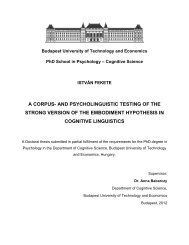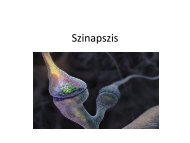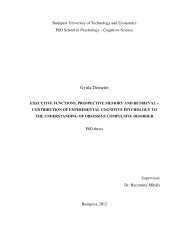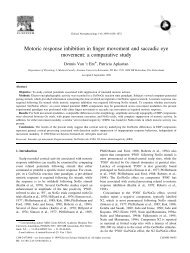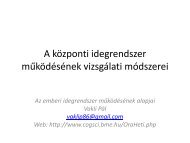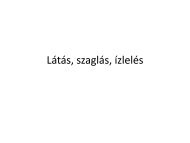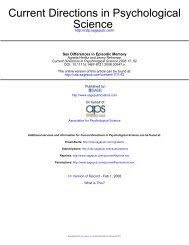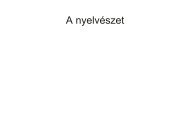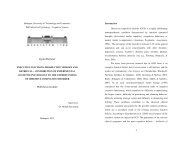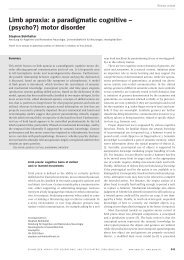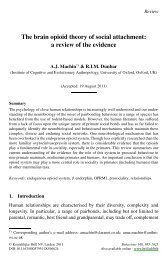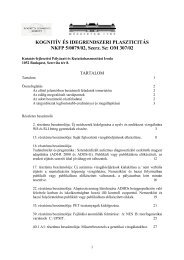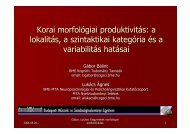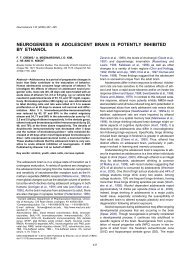Verbs: some properties and their consequences for agrammatic ...
Verbs: some properties and their consequences for agrammatic ...
Verbs: some properties and their consequences for agrammatic ...
Create successful ePaper yourself
Turn your PDF publications into a flip-book with our unique Google optimized e-Paper software.
244<br />
Condition 1: matrix clause<br />
Dutch �1movement)<br />
Tester: Dit is de man die de tomaat snijdt en dit is de man die het brood snijdt. Dus deze<br />
man snijdt de tomaat en deze man¼<br />
Patient: `snijdt het brood'.<br />
�lit: this is the man that the tomato cuts <strong>and</strong> this is the man that the bread cuts. So,<br />
this man cuts the tomato <strong>and</strong> this man¼.<br />
[Patient:`cuts the bread'])<br />
English �2movement)<br />
Tester: This is the man that cuts the tomato <strong>and</strong> this is the man that cuts the bread. So,<br />
this man cuts the tomato <strong>and</strong> this man¼<br />
Patient: `cuts the bread'<br />
Condition 2: embedded clause<br />
Dutch �2movement)<br />
Tester: Deze man snijdt de tomaat en deze man snijdt het brood. Dus dit is de man die de<br />
tomaat snijdt en dit is de man die¼<br />
Patient: `het brood snijdt'.<br />
�lit: this man cuts the bread <strong>and</strong> this man cuts the tomato. So this is the man that<br />
the tomato cuts <strong>and</strong> this is the man that¼<br />
[Patient: `the bread cuts'])<br />
English �2movement)<br />
Tester: This man cuts the tomato <strong>and</strong> this man cuts the bread. So, this is the man that cuts<br />
the tomato <strong>and</strong> this is the man that¼<br />
Patient: `cuts the bread'<br />
The reason to prompt the patient with the verb <strong>and</strong> the noun several times be<strong>for</strong>e s/he<br />
was supposed to produce it was to avoid interference with word-®nding problems. Each set<br />
of pictures was used twice, once with a matrix clause <strong>and</strong> once with an embedded clause to<br />
complete. The test started with two examples that were repeated until it was clear that the<br />
patient understood the task.<br />
The test has been presented to three �Dutch) healthy speakers, who had no problems<br />
with any of the items �all scored 100% correct). For a different study on language acquisition,<br />
the test has also been presented to ten 8-year-old �Dutch) children, who per<strong>for</strong>med<br />
faultlessly �Zuckerman, Bastiaanse & Van Zonneveld, 2001). There<strong>for</strong>e, all errors made<br />
by the <strong>agrammatic</strong> aphasics, were supposed to result from <strong>their</strong> aphasia <strong>and</strong> not from test<br />
construction.<br />
2.3. Scoring<br />
R. Bastiaanse et al. / Journal of Neurolinguistics 15 �2002) 239±264<br />
A simple correct/incorrect scoring system was used, in which determiner omission was<br />
ignored. Self-corrections were allowed <strong>and</strong> the ®nal answer was the one that was analyzed.<br />
If requested, the examiner repeated the cueing sentences once. Post-hoc, an error analysis<br />
system was developed on the basis of the most frequently occurring errors: verb omissions,



